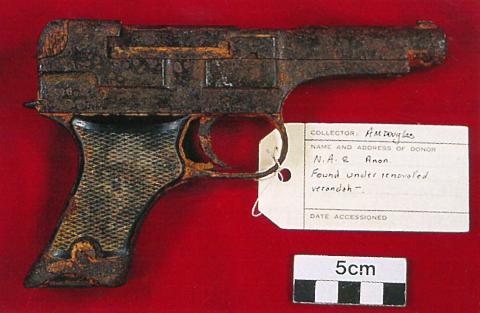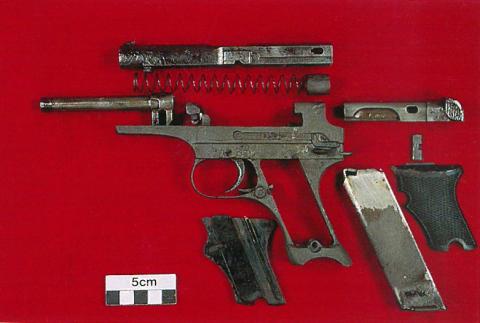Firearms
S. R. Garcia
Introduction
There is an increasing interest being taken in the conservation and restoration of firearms. Firearms have figured prominently in Australia’s history and are present in great numbers, particularly in the rural community. Gun laws are generally strict, even for display purposes. Contact police in your state regarding regulations which apply to the repair and handling of firearms.
Construction and Deterioration
Firearms are composite objects usually made up of steel of various grades, wood and inlays of varying material types. Take care when treating them, especially when components have corroded into a solid rusty mass. This is a common problem as the components of the mechanisms are small and intimately positioned. Dirt and unfavourable environmental conditions can ‘fuse’ these components together.
Safety
Before work of any kind is attempted on a firearm, check that it is not loaded or cocked. If there is any doubt as to its safety, seek help from an approved agency or person.
Documentation
Before treatment, take full notes, diagrams and photographs of the object’s condition.
Treatments
Cleaning
If a weapon is in a good state of repair, following the guidelines below will assist in maintaining that condition:
- wear gloves when handling the firearm to stop oils and acids from the skin etching the metal surface;
- light oiling may be all that is needed to maintain the firearm’s steel components. Use an approved light gun oil and a lint-free rag;
- if necessary strip the firearm, clean the components in an approved degreaser, dry, lightly re-oil and reassemble the firearm. Use a lint-free rag when cleaning and oiling;
- dissolve heavy grease with caustic solution;
- a touch-up ‘blueing’ solution is available if this finish is applicable. Clean the surface to remove all dirt, oils and grease prior to applying the ‘blueing’ solution; and
- clean inlays according to their material type (see relevant chapters).
If on the other hand a firearm is in a badly corroded condition more intervention will be necessary. Such a situation is well illustrated by examining the treatment of a .32 calibre Japanese pistol (Figure 1). For this object treatment consisted of:
- stripping the firearm as far as possible;
- immersing the corroded iron components in a solution of caustic soda (20 - 50 g) in water (1 L) to remove all dirt, paint, grease and similar materials. No aluminium or wooden components were immersed;
- separating other components, using a combination of gentle heating, along with a lubricant such as CRC or WD 40 to loosen and remove nuts and screws. No heat was applied to springs;
- soaking the dismantled components (except the springs) in a solution of citric acid (20 – 50 g) in water (1 L) and gently brushing to remove rust;
- washing the components with caustic soda solution (see above) to neutralise any residual acid, then with fresh water to remove excess caustic and finally with a dewatering agent such as CRC or WD 40;
- wiping the parts dry and coating them with a solution of fish oil (20 %) in white spirit (80 %). A light gun oil is an acceptable alternative;
- washing the plastic hand grips in fresh water and physically cleaning them with a soft brush; and
- re-assembling the pistol. The mechanism could be activated following assembly.
Figure 1: Japanese pistol.
(a) Before treatment.
(b) After treatment.
Wooden Components
Clean polished or waxed stocks and handgrips with a clean soft rag or soft brush. Gun stock oils are available to refurbish wooden components if desired.
Preventive Conservation
After treatment the weapon was wrapped in acid-free tissue and stored in an enamelled metal cabinet. Check stored firearms every six to twelve months for signs of deterioration.


